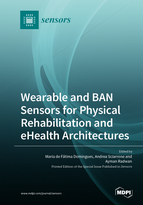Wearable and BAN Sensors for Physical Rehabilitation and eHealth Architectures
A special issue of Sensors (ISSN 1424-8220). This special issue belongs to the section "Sensor Networks".
Deadline for manuscript submissions: closed (31 July 2021) | Viewed by 48414
Special Issue Editors
2. Instituto de Telecomunicações, Aveiro, Portugal
Interests: optical fiber sensors; fiber Bragg gratings; Fabry-Perot interformetric sensors; eHealth applications; gait analysis; wearable sensing devices
Special Issues, Collections and Topics in MDPI journals
Interests: digital signal processing; eHealth applications; mobile computing
Special Issues, Collections and Topics in MDPI journals
Interests: wireless communications; radio resource management; Internet of Things; future generations of mobile communications (5G)
Special Issues, Collections and Topics in MDPI journals
Special Issue Information
Dear Colleagues,
The demographic shift of the population towards an increase in the number of elder citizens, together with the sedentary lifestyle we are adopting, is reflected in the increasingly debilitated physical health of the population. The resulting physical impairments require rehabilitation therapies which may be aided by the use of wearable sensors or body area network sensors (BANs). The use of novel technology for medical therapies can also contribute to reducing the cost in healthcare systems and decrease patient overflow in medical centers. Sensors are the primary enablers of any wearable medical device, with a central role in eHealth architectures. The accuracy of the acquired data relies on the sensors; hence, when considering wearable and BAN sensing integration, they must prove to be accurate and reliable solutions.
This Special Issue will focus on the current state-of-the-art of BANs and wearable sensing devices for physical rehabilitation of impaired or debilitated citizens. It will cover novel technological achievements related to different sensing technologies (optical or electronic), their design, and implementation. Both original research papers and review articles describing the current state-of-the-art are welcome. We hope this SI will provide you with an overview of the present status and future outlook of the aforementioned topics.
The manuscripts should cover but need not be limited to the following topics:
- Optical fiber sensing of physiological parameters;
- Wearable biomedical sensors;
- Optical fiber non-invasive devices;
- Optical fiber sensors in e-Health architectures;
- Body area network sensors (BANs);
- Energy efficient eHealth architectures;
- Big data analysis for eHealth;
- Sensors for physical rehabilitation;
- Innovative materials for sensing design;
- Advanced signal processing techniques;
- Applications including, but not limited to physical rehabilitation, robotics, medical diagnostics and therapy, and cardiovascular and pulmonary rehabilitation.
Dr. Andrea Sciarrone
Dr. Ayman Radwan
Guest Editors
Manuscript Submission Information
Manuscripts should be submitted online at www.mdpi.com by registering and logging in to this website. Once you are registered, click here to go to the submission form. Manuscripts can be submitted until the deadline. All submissions that pass pre-check are peer-reviewed. Accepted papers will be published continuously in the journal (as soon as accepted) and will be listed together on the special issue website. Research articles, review articles as well as short communications are invited. For planned papers, a title and short abstract (about 100 words) can be sent to the Editorial Office for announcement on this website.
Submitted manuscripts should not have been published previously, nor be under consideration for publication elsewhere (except conference proceedings papers). All manuscripts are thoroughly refereed through a single-blind peer-review process. A guide for authors and other relevant information for submission of manuscripts is available on the Instructions for Authors page. Sensors is an international peer-reviewed open access semimonthly journal published by MDPI.
Please visit the Instructions for Authors page before submitting a manuscript. The Article Processing Charge (APC) for publication in this open access journal is 2600 CHF (Swiss Francs). Submitted papers should be well formatted and use good English. Authors may use MDPI's English editing service prior to publication or during author revisions.
Keywords
- optical fiber sensors
- biomedical sensors
- wearable sensors
- e-Health
- body-area-network sensors
- smart health









